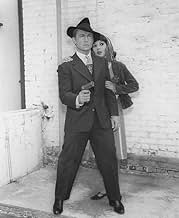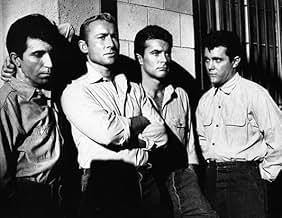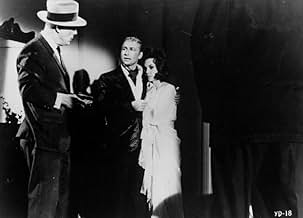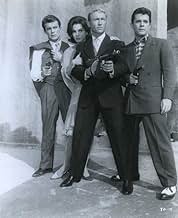John Dillinger first goes to jail after attempting to rob his girlfriend's father at her suggestion. Falling in with the likes of Nelson and Floyd, he arranges their escape and they start on... Read allJohn Dillinger first goes to jail after attempting to rob his girlfriend's father at her suggestion. Falling in with the likes of Nelson and Floyd, he arranges their escape and they start on an escalating series of hold-ups.John Dillinger first goes to jail after attempting to rob his girlfriend's father at her suggestion. Falling in with the likes of Nelson and Floyd, he arranges their escape and they start on an escalating series of hold-ups.
Beverly Powers
- Floyd's Girl
- (as Beverly Hills)
Featured reviews
Pretty much agree with the majority of the eleven previous reviewers that this is mostly trashy boredom with occasional trashy fun. Worst thing about it is how cheesy a production it is. Not only does it look like TV, but cheap ass TV, to boot. More "Highway Patrol", say, than "Untouchables" since it makes but a feeble attempt at a period look, and the cinematography is serviceable, at best. Certainly expected more from the great DP, Stanley Cortez, who does whatever the cinematographer's version of phoning it in is (post carding it in?). That it rates a very generous five is due to some nice, twisted supporting bits from Victor Buono as the Sam Jaffe of this ersatz Asphalt Jungle and John Hoyt as a pervy quack. As for Nick Adams, he does what he always does, mumble and method his way through until he decides to yell and go bananas. Mary Ann Mobley is also over the top, especially in the film's second half, but at least she's hot. Bob Conrad (as Pretty Boy Floyd) and John Ashley (as Baby Face Nelson) tend to get lost amid all the tommy guns. As does Terry Morse's direction and Arthur Hoehl and Donald Zimbalest's screenplay. Solid C.
This repetitive 60s TV musical score tries to drown out the absurdly delivered dialog but doesn't succeed. The OVERACTING is just too much for mere loudly redundant riffs to overcome. Lines like "we're trapped". "Tell me about it". And "quit Johnny, I don't want my baby to lose her father" are offered with either no passion at all or shouted with such ridiculous intensity that you must laugh. The shoot outs are brutally executed with incredibly stupid victims waiting to be "gunned down" by the vicious most at all misunderstood young men who seem to
kill without conscious or motive. Johnny Yuma was supposed to be a rebel..,Johnny Dillinger had no motivation...unless he just wanted to get away from
That incredibly noisy music in his head.
All he wants to do is to marry Mary Ann Mobley, but they've got no money. At her urging Adams robs her father's business, killing a guard in the process, then it's off to find a Justice of the Peace.... but they're too young to get married, so they head off to honeymoon anyway. But Miss Mobley's father wants his money back, so it's off to prison for Adams, where he meets the nicest people, like Pretty Boy Floyd -- Robert Conrad -- Baby Face Nelson -- John Ashley. Adams escapes, then breaks his friends out, killing a few guards in the process, and it's off to the race.
This looks like it anticipates a lot of things about BONNIEAND CLYDE, but in a B movie way. Terry Morse hadn't directed a movie in almost ten years. Instead he practiced his other craft, that of editor, and he had Stanley Cortez helming the camera. As a result, visually and in terms of pacing, it's excellent; The heist and fighting sequences are excellent (if you can ignore Shorty Rogers bombastic, jazzy score), but the performances are all over the shop, from Conrad solid performance, to Victor Buono's over-the-top mastermind, to Miss Mobley's whiny hysteria.
It's one of the increasingly violent crime movies of the 1960s, and like the pre-code era, it ends with a pious paean to the cops who guard the citizenry. It didn't stop local station managers from shutting down a network broadcast in 1968, about the time that Adams died of a drug overdose at the age of 36.
This looks like it anticipates a lot of things about BONNIEAND CLYDE, but in a B movie way. Terry Morse hadn't directed a movie in almost ten years. Instead he practiced his other craft, that of editor, and he had Stanley Cortez helming the camera. As a result, visually and in terms of pacing, it's excellent; The heist and fighting sequences are excellent (if you can ignore Shorty Rogers bombastic, jazzy score), but the performances are all over the shop, from Conrad solid performance, to Victor Buono's over-the-top mastermind, to Miss Mobley's whiny hysteria.
It's one of the increasingly violent crime movies of the 1960s, and like the pre-code era, it ends with a pious paean to the cops who guard the citizenry. It didn't stop local station managers from shutting down a network broadcast in 1968, about the time that Adams died of a drug overdose at the age of 36.
This forgotten film belongs to the movies made in the early sixties, and telling the stories - more or less fictionnal - of authentic gangsters: MURDER INC, PORTRAIT OF A MOBSTER, RISE AND FALL OF LEGS DIAMOND, BABY FACE NELSON, MAD DOG CALL, PURPLE GANG, PRETTY BOY FLOYD.... And many other items. This one is far from being a masterpiece, the director was himself a horror B movie vet film maker, not Don Siegel nor Phil Karlson; but the result is surprisingly good, far better than I could expect. And what a exquisite pleasure to watch Robert Conrad just before he entered WILD WILD WEST terrific TV show.
The poor man's James Dean during the 1950s, Nick Adams always felt that he'd been born at the wrong time. He wanted to be a James Cagney type tough guy in Depression-era gangster films. He finally had the chance to make that dream come true, if on an ultra-cheap budget, with this wildly inaccurate tale of John Dillinger and his bank robbing gang. At one point, Adams even does a Cagney imitation, the hilarious high point of what is, sad to say, a rather inept film, if an intriguing one all the same. Mary Anne Mobley plays his gun moll with gusto, and best pal Pretty Boy Floyd is portrayed by Adams' own best friend, Robert Conrad. Various semi-stars, from Victor Buono to John Hoyt, show up in cameos. I love the scene in which a plastic surgeon (Hoyt) tries to change "Johnny's" face, but it remains the same - and so, going Richard Widmark one better from Kiss of Death, Dillinger cackles with laughter as he tosses the chairbound doctor into a pool and watches him drown. Adams co-produced, and the film's failure left him distraught - and somewhat destitute. When the film was shown on CBS TV three years later, Adams even lost his top-billing, as Conrad (who had become a star thanks to The Wild, Wild West on that network) was given that honor for the telecast. A day after the broadcast, Adams was found dead in his apartment, an apparent suicide. Come on, Nick - it wasn't THAT bad!
Did you know
- TriviaOnly one year later Victor Buono will repeat his pompous, criminal mastermind types in the "Batman", "The Man from Uncle", and rejoining Robert Conrad in "The Wild, Wild West" television series.
- GoofsNighttime scenes were filmed during daylight hours. Not only were filters NOT used, the film was not even underexposed to give the appearance of darkness. Instead everything was bright and so well lit that the background detail would stand out where there should have only been at best shadows if not black from the darkness.
- Crazy creditsExtant prints have a Lorimar logo replacing the original "Allied Artists Presents" card.
- ConnectionsFeatured in The Unknown World of Terrell O. Morse (2025)
Details
- Release date
- Country of origin
- Language
- Also known as
- Staatsfeind Nr.1 - John Dillinger
- Filming locations
- Production company
- See more company credits at IMDbPro
- Runtime
- 1h 42m(102 min)
- Color
- Sound mix
- Aspect ratio
- 1.66 : 1
Contribute to this page
Suggest an edit or add missing content





































